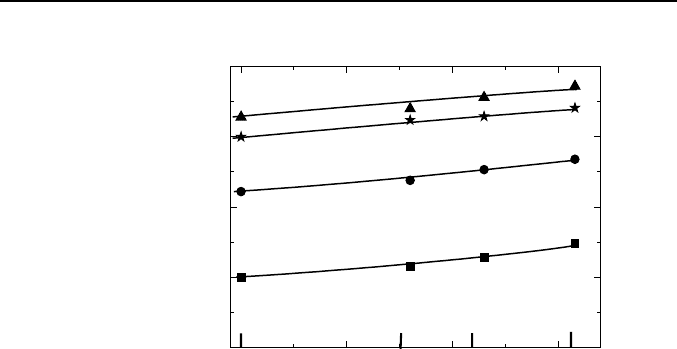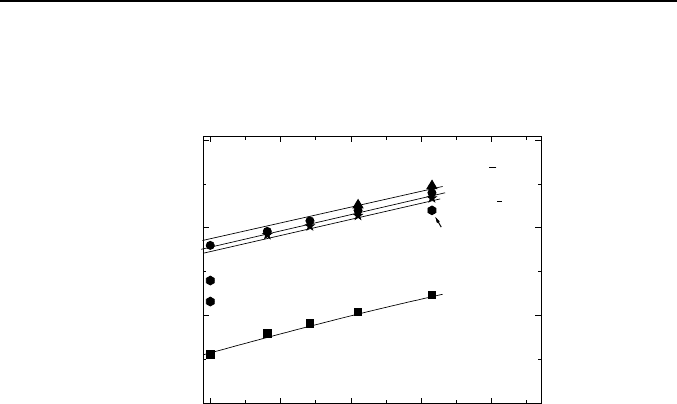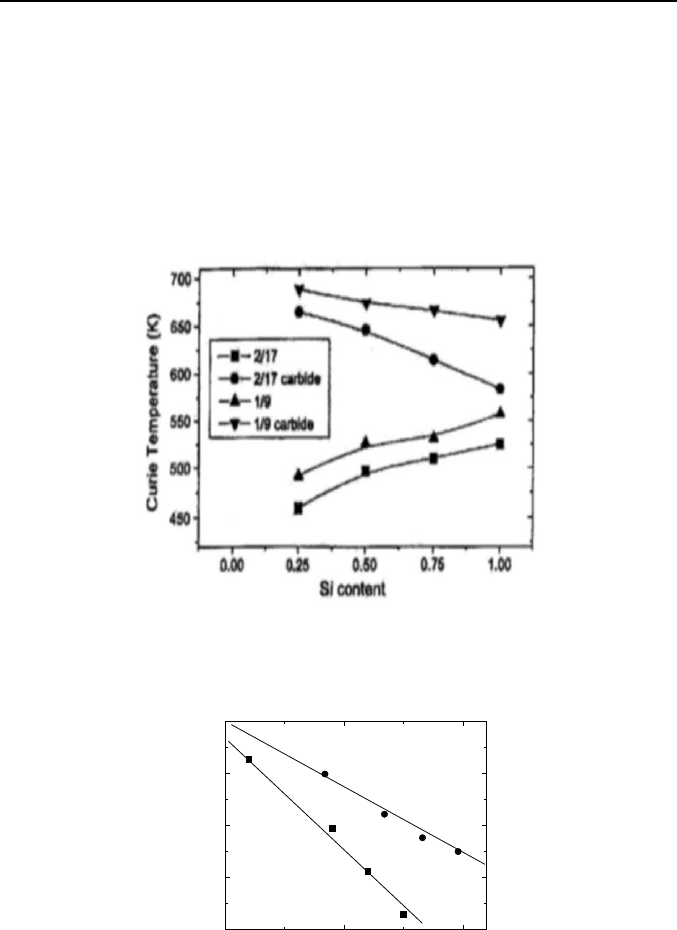Gross R., Sidorenko A., Tagirov L. Nanoscale Devices - Fundamentals and Applications
Подождите немного. Документ загружается.

Nanocrystalline Iron-Rare Earth Alloys: Exchange
Interactions and Magnetic properties
E. Burzo
1
, C. Djega–Mariadassou
2
1
Faculty of Physics, Babes-Bolyai University 400084 Cluj-Napoca,
Romania
2
LCMTR UPR 209 CNRS 2/8 Bat F Rue Henri Dunant 94320 Thiais,
France
Abstract: The exchange interactions in R
2
Fe
17
compounds are analyzed. The
contributions to R5d band polarizations are estimated. Then, the
physical properties of nanocrystalline Sm(Fe,Si)
9
alloys are studied in
correlation with possible technical applications. Finally, the magnetic
properties of the Nd
5
Fe
66.5-x
Cr
10
M
x
B
18.5
nanocomposite system with
M = V or Nb are analyzed.
Keywords: rare earth compounds, magnetic properties
Introduction
Nanocrystalline alloys have very interesting physical properties with a
large variety of useful technical applications [1]. The systems based on
rare-earth (R)-transition metals (M) are particularly interesting as materials
for permanent magnets. In this article we focus on R
2
Fe
17
and R
2
Fe
14
B-
based compounds. A characteristic feature of both systems is their low
Curie temperature T
C
. For R
2
Fe
17
compounds the highest T
C
value was
shown to be 477 K for R = Gd [2]. Somewhat higher Curie temperatures,
around 600 K, were found in R
2
Fe
14
B system [3]. The above values are
about half of the Curie temperature of pure iron, although the iron content
in the above compounds is about 90%. Furthermore, in both systems the
iron moments are close to that of pure iron. Due to the low T
C
values and
planar
anisotropies, the R
2
Fe
17
compounds have been considered as not
371
R. Gross et al. (eds.), Nanoscale Devices - Fundamentals and Applications, 371–385.
© 2006 Springer. Printed in the Netherlands.

372 E. Burzo, C. Djega–Mariadassou
useful for technical applications such as permanent magnets. At present, the
Nd
2
Fe
14
B is the basic component for high energy permanent magnets [3].
The low Curie points in both R
2
Fe
17
and R
2
Fe
14
B type compounds were
attributed to the strong distance dependence of the exchange interactions
[4]. The R
2
Fe
17
compounds crystallize either in hexagonal or orthorhombic
crystal structures. In both structures there are four different iron sites. In
contrast, the R
2
Fe
14
B compounds have a tetragonal structure. In this lattice
structure there are six crystallographically different iron sites, two R
positions and one boron site. The distances between iron atoms, d
FeFe
, in the
above systems cover a large range of values. The interactions between iron
atoms situated at distances d
FeFe
≤ 2.45 Å are negative, whereas the
exchange interactions between Fe atoms situated at larger distances than the
above value are positive. There are no negative exchange interactions, since
for the particular sites they are smaller than the positive ones. Nevertheless,
a considerable magnetic energy is stored in them. As a result, there is a
strong decrease of the Curie temperatures in both systems.
The exchange interactions in rare-earth-transition metal compounds are
rather complex. The exchange interactions of R-Fe type can be described by
Campbell’s model [5]. In this model the 4f electrons of the rare-earth
polarize their 5d bands and there are short-range 5d-3d exchange
interactions with neighbouring iron atoms. The local 4f-5d exchange
interactions are positive and the 4f and 5d moments will align parallel. An
additional contribution to 5d band polarization resulting from 5d-3d short
range interactions is also expected. The Fe(3d)-Fe(3d) exchange
interactions are short range.
In this paper we analyze the exchange interactions in R
2
Fe
17
and R
2
Fe
14
B
compounds. Then, we present the physical properties of Sm-Fe-Si-C
nanocrystalline alloys with the ratio R/(Fe,Si) close to 2/17 having possible
technical applications. In the last part, we report on the physical properties
of Nd-Fe-Cr-M-B nanocomposite magnets with M=V or Nb based on
Nd
2
Fe
14
B type and α-Fe.
Experimental and Numerical Methods
The Sm
2
Fe
17-x
Si
x
and SmFe
9-y
Si
y
nanocrystalline alloys were obtained by
high energy ball milling of Sm-Fe pre-alloyed powders and balanced
quantity
of silicon and samarium powders. The samples were heat treated
in vacuum at temperatures between 650
o
C and 1150
o
C. Carbonation of the
samples was achieved by reaction of the alloy powder with appropriate
amount of C
14
H
10
powder [6].

Nanocrystalline Iron-Rare Earth Alloys 373
The Nd
5
Fe
66.5-x
Cr
10
M
x
B
18.5
alloys with M=V or Nb were obtained by arc
melting the constituents under purified argon atmosphere. Then, flakes
were prepared by melt-spinning the alloys onto a cooper wheel in argon
atmosphere. The amorphous precursors of nanocrystalline alloys were heat
treated at 650
o
C from 0.5 to 10 min.
The X-ray analyses of Sm-Fe-Si alloys were performed with a Brucker-
type diffractometer. The crystal structures and lattice site coordinates were
obtained by Rietveld analysis by using the FULLPROF computer code in
the assumption of Thompson-Cox-Hastings line profile, which permitted
the refinement of the coexisting phases and also to take into account the
broadening of the diffraction lines induced by grain size and strain effects.
The mean grain sizes in Nd-Fe-Cr-M-B nanocomposites were determined
from the broadening of X-ray line by using the Scherrer formula [7, 8]. The
distribution functions of the grain sizes were also determined.
Magnetic measurements were performed in the temperature range 4.2-
800 K and fields up to 9 T.
Band structure calculations were performed by using the ab initio tight
binding linear muffin tin orbital method in the atomic sphere approximation
(TB-LMTO-ASA) [9]. In the framework of the local density approximation
(LDA), the total electronic potential is the sum of external, Coulomb and
exchange correlation energies [10]. The functional form of the exchange
correlation energy, used in the present work, was the free electron gas
parameterization of Von Barth and Hedin [11]. Relativistic effects were
included. The 4f states were treated as part of core. These electrons are not
part of the band structure, but the polarization of the 4f densities was
calculated self–consistently.
Exchange Interactions in R
2
Fe
17
and R
2
Fe
14
B Type
Compounds
As mentioned already above, the exchange interactions between R and Fe
atoms can be described as of 4f-5d-3d type, while those between transition
metals are of short-range 3d-3d type. According to the Néel-Slater curve,
for the rhombohedral
3
R
m type structure of the R
2
Fe
17
compounds, the
interactions between Fe atoms situated in dumbbell 6c sites are strongly
negative. The exchange interactions between Fe(9d)-Fe(18f) are weakly
negative [12]. The exchange interactions between iron atoms situated at
larger distances are positive and impose a parallel alignment of the iron
moments. Similar behaviour can be seen in the hexagonal P6
3
/mmm type
structure of R
2
Fe
17
compounds.

374 E. Burzo, C. Djega–Mariadassou
0 5 10 15
1.50
1.75
2.00
2.25
2.50
Y
6g
12k
4f
12j
Gd
Tb
Ho
M
Fe
(µ
B
/atom)
(9
J
-1)
2
J(J+1)
Fig. 1. The iron moments as function of De Gennes factor for hexagonal R
2
Fe
17
heavy rare-earths and yttrium compounds.
The dependences of the iron moments determined from band structure
calculations as function of De Gennes factor, G, are given in Fig. 1 for the
case of hexagonal R
2
Fe
17
compounds, where R is a heavy rare-earth or
yttrium. The iron moments follow linear dependences M
Fe
=M
Fe
(0)+
α
G,
where
α
= 4⋅10
-2
µ
B
for all type of sites and G = (g
J
-1)
2
J(J+1) [13]. From
these data it can be seen that a fraction of (5-7) % of the iron moments is
induced by 4f-5d-3d exchange interactions when replacing Y by Gd. The
sequence of the decreasing the Fe moments is 4f > 12j > 12k > 6g. The iron
magnetic moments are sensitive to their local environments. We note that in
the above sequence the 4f and 12j are inverted, when only the spin
contributions are considered in the computing method.
The R5d band polarizations for R
2
M
17
(M = Fe, Co, Ni) as well as for
R
2
Fe
14
B (R= Gd,Y) compounds follow also linear dependences as a
function of the De Gennes factor, M
5d
= M
5d
(0)+
β
G (see Fig 2). The M5d
polarizations are translated to higher values as the magnetizations of the
transition metal sublattices are higher. The slopes β ≅ 1×10
-2
µ
B
are nearly
the same for all R
2
M
17
systems. For the P6
3
/mmc type structure of R
2
Fe
17
compounds, where two R sites are present (2b and 2d), their M
5d
values are
only slightly different and the mean value was only plotted in Fig. 2. A
higher difference between the M
5d
band polarizations at R4f and R4g sites
can be seen in the R
2
Fe
14
B compounds. The observed differences can be

Nanocrystalline Iron-Rare Earth Alloys 375
correlated with their different local environments, with the R(4g) site
having a higher number of boron atoms in the first coordination shell.
0 5 10 15 20
0.00
0.25
0.50
0.75
RFe
7
B
0.5
R
2
Ni
17
(P6
3
/mmc)
R
2
Co
17
(R3m)
R
2
Fe
17
(P6
3
/mmc)
R
2
Fe
17
(R3m)
M
5d
(µ
B
/atom)
(9
J
-1)
2
J(J+1)
Fig. 2. The computed 5d band polarizations for R
2
M
17
(M=Fe, Co, Ni) heavy-rare
earths compounds and GdFe
7
B
0.5
. The Y 4d band polarizations in Y
2
Ni
17
, Y
2
Fe
17
and YFe
7
B
0.5
are also plotted.
The R5d band polarizations for R
2
M
17
(M = Fe,Co,Ni) as well as for
R
2
Fe
14
B (R= Gd,Y) compounds follow also linear dependences as a
function of the De Gennes factor, M
5d
= M
5d
(0)+
β
G (see Fig 2). The M5d
polarizations are translated to higher values as the magnetizations of the
transition metal sublattices are higher. The slopes β ≅ 1×10
-2
µ
B
are nearly
the same for all R
2
M
17
systems. For the P6
3
/mmc type structure of R
2
Fe
17
compounds, where two R sites are present (2b and 2d), their M
5d
values are
only slightly different and in Fig. 2 only the mean value was plotted. A
higher difference between the M
5d
band polarizations at the R4f and R4g
sites can be seen in the R
2
Fe
14
B compounds. The observed differences can
be correlated with their different local environments, with the R(4g) site
having a higher number of boron atoms in the first coordination shell.
The analysis of the data in Fig. 2 shows the presence of two contributions
to the R5d band polarization. The βG contribution is due to local 4f-5d
exchange and is the same for a given R atom. The M
5d
(0) values obtained
by extrapolation of the M
5d
vs G dependences to G = 0 are the same as those
induced on the 4d band by 4d-3d short range exchange interactions in the
Y
2
M
17
compounds. Thus, this contribution can be only ascribed to the
presence of 5d-3d short range exchange interactions resulting from
hybridization effects.

376 E. Burzo, C. Djega–Mariadassou
The effect of short-range exchange interactions on the R5d band
polarization can be analyzed starting from Hamiltonian which takes into
account both 3d-5d and 5d-5d exchange interactions [14].
3553 5555
2 (0) (0) 2 (0)
dd d di dd d dj
ij
H
JS S JS S
−−
=
−−
∑∑
,
(1)
where J
3d-5d
and J
5d-5d
are the exchange parameters characterizing the 3d-5d
and 5d-5d interactions with i an j the nearest neighbors Fe and R atoms,
respectively, and S
5d
(0) and S
3d
(0) are the spin values characterizing the
systems with G = 0.
0 5 10 15 20
0.0
0.1
0.2
0.3
0.4
0.5
M
d
(µ
Β
/RM
8.5
or RFe
7
B
0.5
)
YFe
7
B
0.5
Fe
Co
Ni
R3m
P6
3
/mmc
M
5d
(0)(
µ
Β
/atom)
Fig. 3. The M
5d
(0) contributions to 5d band polarizations as a function of the
transition metal moments in the RM
8.5
(M=Fe, Co, Ni) rare earth compounds as
well as the mean value of M
4d
in YM
7
B
0.5
.
The relation (1) can be analyzed in the molecular field approximation.
The effect of 5d-3d and 5d-5d exchange interactions is equivalent to an
internal field, H
exch
, acting on the R atom. This induces an additional
polarization to that resulting from 4f-5d local exchange, similar to that
evidenced on 3d band in rare-earth transition metal compounds [15]. The
internal field is H
exch
= N
5d-3d
M
3d
+ N
5d-5d
M
5d
where N
5d-3d
and N
5d-5d
are the
molecular field coefficients describing the R5d-Fe3d and R5d-R5d
exchange interactions. The R5d-R5d exchange interactions can be
neglected as compared to R5d-Fe3d, since the former are very small [14].
Thus, it the relevant result is that H
exch
is proportional to M
d
, where M
d
is
the total 3d magnetization per formula unit. Previously [15], we showed
that above a critical field, which determines the appearance of 3d magnetic
moments, M
3d
is proportional to the exchange field, H
exch
. Supposing that
this relation is valuable for the 5d band, it follows that M
5d
(0) = αM
Fe
. The

Nanocrystalline Iron-Rare Earth Alloys 377
M
5d
(0) values determined in RM
8.5
(M = Fe, Co, Ni) and the mean value
obtained for YFe
7
B
0.5
compounds are plotted in Fig. 3 as a function of the
total transition metal magnetization corresponding to one R atom. There is
a linear dependence, in agreement with the above conclusions. The
determined slope is α = 0.028 ± 0.004. Assuming that the induced 5d band
polarization by short range 5d-3d exchange interactions is the same as that
induced in the Fe 3d band when changing the exchange interactions due to
substitution of a nonmagnetic rare earth by a magnetic one it is found that
M
5d
(0) = (18×10
2
)
-1
H
exch
, where M
5d
(0) is given in Bohr magnetons and
H
exch
in T . Supposing that N
5d-3d
≅ N
R-Fe
we can estimate also the induced
5d polarization, M
5d
(0). For N
Fe-R
≅ 30, as found in R
2
Fe
17
compounds [16],
we obtained a value α = 0.011 somewhat smaller than that determined from
Fig. 3. This shows that the R5d band is more sensitive to exchange
interactions than the Fe3d band, and is comparable to that found for the 3d
band.
Nanocrystalline Sm-Fe-Si-C Alloys
As function of the thermal treatment process both stable and metastable
solid solutions can be formed in the Sm-Fe-Si system close to the
composition 2/17. Unlike in the cobalt rare-earth phase diagram, no
presence of a hexagonal CaCu
5
type structure was found in R-Fe system. In
the RCo
5
type compounds a deviation from 1/5 stoichiometry was shown.
The alloys were described by the formula R
1-s
Co
5-2s
, where s rare-earth
atoms are substituted by s dumbbells pairs of cobalt [17, 18]. The presence
of metastable R
1-s
Fe
5+2s
phases was also reported [19]. For s = 0.22, a
TbCu
7
type structure can be invoked, while for s = 0.36 ÷0.38 a 1/9
stoichiometry was found with the alloys having P6/mmm type structure. If
s = 0.33, a single R atom out of three is substituted for by one dumbbell
pair and the stoichiometry is 2/17. If the dumbbell pairs are randomly
distributed, the structure remains hexagonal and is of P6/mmm type. This
structure is closely related to CaCu
5
one (see Table 1). In the theoretical
Sm
1-s
Fe
5+2s
system, the 3g sites occupation is not affected, while for
s = 0.22 the 2c site of the CaCu
5
-type structure would transform partially
into
Fe6l. The 2e sites are gradually occupied by iron. The Sm
1-s
Fe
5+2s
system exhibit experimentally only the metastable P6/mmm phase with
s = 0.36-0.38 consistent with SmFe
9-y
Si
y
after annealing at 650-850
o
C
.
These alloys are nanocrystalline with grain sizes varying from 22 to 28 nm.
The 2/17 stoichiometry is approached when increasing the annealing
temperature
compared to the above mentioned. The P6/mmm type
structure changes to a rhombohedral
3
R
m type through an ordering

378 E. Burzo, C. Djega–Mariadassou
process of atoms. Thus, the 2e and 6l sites transform into 6c and 18h sites,
respectively. The 3g site splits from one third into 9d positions and two
third into the 18h sites in the rhombohedral 2/17 phase. The R1a site gives
rise to the R6c site in the
3
R
m type structure.
Table 1. Atom occupancies and positions in the R
1-s
M
5+2s
alloys having P6/mmm
space group [6].
Atom s = 0
1/5
s = 0.22
TbCu
7
type [20]
s = 0.33
2/17
s = 0.36
1/9
1Sm(1a) 1-s 1 0.78 0.66 0.64
2Fe(2c) 2(1-3s) 2 2 0 0
6Fe(6l) 6s 0 0 2 2
3Fe(3g) 3 3 3 3 3
2Fe(2e) 2s 0 0.44 0.66 0.72
In hexagonal R
2
Fe
17
based compounds the substitution of one Fe atom by
Si decreases the R(5d) band polarization by ≅ 0.04 µ
B
. This can be
correlated with the diminution of short range R(5d)-Fe(3d) exchange
interactions due to dilution effects.
0.0 0.4 0.8 1.2 1.6 2.0
8.50
8.55
8.60
8.65
8.70
12.40
12.45
12.50
Sm
2
Fe
17-x
Si
x
C
z
x
a(Å) c(Å)
0.00 0.25 0.50 0.75 1.00
4.2
4.4
4.9
5.0
SmFe
9-y
Si
y
C
z
a(Å) c(Å)
y
Fig. 4. Composition dependences of lattice parameters in Sm
2
Fe
17-x
Si
x
C
z
z = 0 (•),
2(
*
) and Sm
2
Fe
9-y
Si
y
C
z
z = 0 (•), 1(
*
) alloys.
The composition dependences of the lattice parameters for
Sm
2
Fe
17-x
Si
x
C
z
(z=0, 2) and SmFe
9-y
Si
y
C
z
(z=0, 1) alloys are shown in
Fig. 4.
A
rhombohedral
type
structure
having
3
R
m
space group was
found for Sm
2
Fe
17-x
Si
x
compounds with x ≤ 2.0. The metastable SmFe
9-y
Si
y
solid solutions are formed up to y = 1.04 and crystallize in hexagonal
P6
3
/mmm type structure. The a- and c-lattice parameters decrease when
replacing iron by silicon in Sm
2
Fe
17-x
Si
x
system. The silicon atoms are
located in 18h sites. The same behaviour was shown for Sm
2
Fe
17-x
Si
x
C
2

Nanocrystalline Iron-Rare Earth Alloys 379
carbonated samples, although a rather high increase of the cell parameters
was shown after carbonation. In the case of hexagonal P6
3
/mmm alloys, in
which the SmFe
9-y
Si
y
and SmFe
9-y
Si
y
C systems crystallize, the c lattice
parameters decrease while the a-parameters increase slightly. We note that
as in the 2/17 compounds the carbonation leads to a high increase of the cell
parameters. Domain sizes of 22 nm were found for the SmFe
9-y
Si
y
C alloy
with y = 0.25. They decrease slightly to 18 nm for y = 1, according to the
role played by silicon on the nanostructure.
Fig. 5. Composition dependences of the Curie temperatures in Sm
2
Fe
17-x
Si
x
C
z
(z=0, 2) and SmFe
9-y
Si
y
C
z
(z= 0, 1) alloys.
450 500 550
2
4
6
8
10
2/17
1/9
Γ
T
C
(K)
Fig. 6. The dependence of the Γ values on the Curie temperatures.

380 E. Burzo, C. Djega–Mariadassou
The composition dependences of the Curie temperatures, T
c
, are given in
Fig. 5. The T
c
values of noncarbonated 1/9 and 2/17 samples increase
gradually showing the same trend, although the T
c
values are higher in the
1/9 phase. The increase of the Curie temperature on replacing iron by
silicon can be attributed to the reduction of the antiferromagnetic exchange
interactions relative to a slight increase of the Fe-Fe distances concomitant
with the filling of the d band by the p silicon electrons implying a shift to
strong ferromagnetic behavior. For example, in the
3
R
m type structure of
Sm
2
Fe
17
compounds, Si replaces Fe in the 18h sites, while the distances
Fe6c-6c and Fe9d-18f increase but remain just below 2.45 Å. The Curie
temperatures in carbonated samples are sensitively higher than those in
noncarbonated. Due to the increase of the lattice parameters by the presence
of interstitial carbon, the distances between iron atoms are larger. This leads
to a decrease or even cancellation of the contributions of the iron pair to the
negative exchange interactions. When substituting Fe by Si, in carbonated
samples, a decrease of the T
C
value is expected due to dilution effects as
well as hybridization effects of Fe3d, Si3p and C3p bands in agreement
with experimental observations.
The correlation between the Curie temperatures and the volume
variations can be analyzed by using the
C
B
ln
1
c
ln
c
dT
dT
kT dp d v
Γ= =
parameter
[21, 22]. Here, κ denotes the compressibility and v is the volume of the
cell. A linear dependence of the Γ values on the Curie temperatures was
reported starting from a model, which considers the 3d electrons as having
mainly a localized behavior [21, 23]. In this model the Γ value is given by:
B
2
ln
55
ef f
0
2
c
2
3ln8
(1)
ef f b
dJ
kNg I
T
dv
SS J I
Γ= + +
+
,
(2)
where N
o
is the Avogadro number, g is the Landé factor, I is the effective
intra-atomic exchange integral, which is reduced from its bare value I
b
, and
J
eff
is the effective exchange coupling parameter. Linear Γ vs T
c
dependences were found and described by the relation Γ = a - bT
C
with
a = 34.5 and b = 0.054 K
-1
for the 2/17 compounds and a = 47.5 and
b = 0.085 K
-1
for 1/9 alloys. These values are close to those determined in
Y
2
Fe
17
C(N)
x
based compounds, where the values a = 38 and b = -0.06 K
-1
were reported [23]. The
ln
ln
eff
dJ
d
γ
ν
= values are 16.4 and 22.9 for the 2/17
